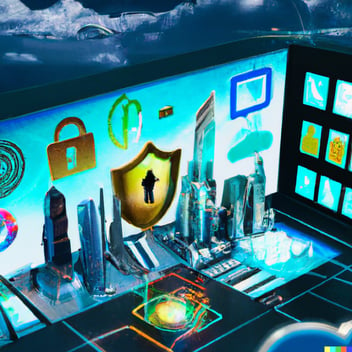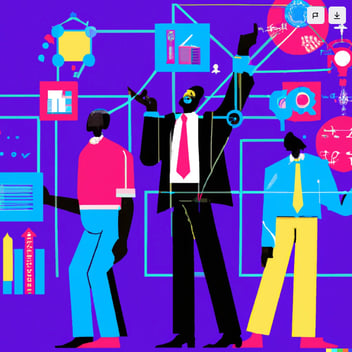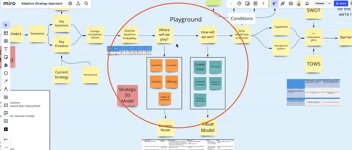1. Adaptive Security
Imagine adaptive security as a skilled team of bodyguards, constantly adjusting and evolving to face new threats. In the age of increasing cybersecurity threats, adaptive security deploys a proactive approach that anticipates potential risks and continually adapts to emerging challenges. Through advanced threat intelligence and predictive analytics, adaptive security systems monitor the digital environment in real-time and react to threats preemptively. It's about staying one step ahead of cybercriminals, ensuring that the government's digital assets are always under robust protection.
By 2026, adaptive security measures will likely be more sophisticated, integrated, and AI-driven. These advanced systems will proactively monitor, predict, and combat potential threats with little to no human intervention.
Opportunities: Adaptive security presents opportunities for creating safer digital ecosystems, enabling governments to safeguard critical information.
Recommendations: Governments should invest in adaptive security technologies and foster collaborations with private entities to improve their cybersecurity infrastructure. Private entities, on the other hand, can innovate in this space by providing tailored solutions that align with government requirements.
2. Cloud-Based Legacy Modernization
Cloud-based legacy modernization is like swapping an old, rusting vehicle for a high-tech, electric one. It involves transitioning from outdated systems to cloud-based solutions, paving the way for improved efficiency, scalability, and cost-effectiveness. Governments can access their data in real-time from anywhere, foster collaboration across departments, and streamline system upgrades. It's about breaking free from the chains of outdated systems and embracing the agility, flexibility, and efficiency of the cloud.
Three years from now, most governmental systems could be operating on modern, cloud-based platforms, enabling real-time, seamless, and secure data access from anywhere.
Opportunities: Cloud-based legacy modernization opens avenues for operational efficiency, improved service delivery, and significant cost savings.
Recommendations: Governments should develop strategies to transition from outdated systems to cloud-based platforms. Private entities can partner with governments to provide these cloud solutions, focusing on security, scalability, and customization.
3. Sovereign Cloud
A sovereign cloud can be likened to a high-security vault where a country's digital treasures are stored. It's a government-controlled cloud storage system that provides an extra layer of protection, ensuring that sensitive data is stored within the nation's geographical boundaries. This not only aids in securing national digital assets but also respects local data residency laws, ensuring compliance and control. It's about fortifying data sovereignty and upholding the digital rights of a nation.
By 2026, sovereign cloud infrastructures might be standard across nations, providing a robust framework for data protection and sovereignty.
Opportunities: The sovereign cloud offers prospects for improved national security, regulatory compliance, and control over data.
Recommendations: Governments should prioritize the development of sovereign cloud infrastructures. Private companies can aid this process by offering technological expertise and solutions that respect national data sovereignty and security norms.
4. Hyperautomation
Imagine hyperautomation as a well-oiled, highly intelligent assembly line, but for information and digital tasks. It involves the application of advanced technologies like AI and machine learning to automate complex processes, not just routine tasks. It combines the power of process automation with the analytical capabilities of AI to create systems that can make decisions, learn from outcomes, and improve over time. By 2026, this powerful blend of automation and intelligence could transform government operations, making them faster, more efficient, and accurate. It's about letting technology handle the grunt work, freeing up human employees to focus on strategic tasks, and improving service delivery at every level. The future of government work isn't just automated; it's hyperautomated.
Hyperautomation could transform governmental operations by 2026, automating complex processes and tasks, improving efficiency, accuracy, and productivity.
Opportunities: Hyperautomation can enhance decision-making, speed up service delivery, and free up resources for more strategic tasks.
Recommendations: Governments should invest in hyperautomation technologies, including AI and ML. Private entities should focus on creating solutions that can automate complex governmental tasks while ensuring transparency, accountability, and ease-of-use.
5. AI for Decision Intelligence
AI for Decision Intelligence is like having a highly efficient and intelligent advisory board working around the clock. It refers to the use of advanced AI and machine learning algorithms to sift through vast amounts of data, providing highly valuable and actionable insights. This technology can help identify patterns and make precise predictions, guiding government bodies in strategic planning and policy-making. It's about taking the guesswork out of the equation and using data-driven insights to make informed decisions.
By 2026, AI could play a pivotal role in government decision-making. With sophisticated predictive analytics and machine learning algorithms, AI can provide deep insights to support informed policy decisions and strategic planning.
Opportunities: AI for decision intelligence offers opportunities to improve accuracy, objectivity, and efficiency in decision-making processes.
Recommendations: Governments should leverage AI capabilities for decision-making, invest in AI literacy, and establish ethical guidelines for its use. Private entities can assist by providing AI-powered solutions that are transparent, accountable, and ethical.
6. Data Sharing as a Program
Data Sharing as a Program is akin to an open-door policy in a large corporation, but instead of conversations, it's all about data. By creating a system that allows different departments to securely access and share relevant data, the government can operate as a more unified entity. This approach enables better collaboration, informed decision-making, and can greatly improve public service delivery. It's not about who has the most data anymore; it's about sharing it and using it effectively.
Data sharing could become a cornerstone of government operation by 2026. A well-structured data sharing program can facilitate collaboration between departments, improving public service delivery and decision-making.
Opportunities: Data sharing programs can lead to more informed policies, increased transparency, and enhanced citizen engagement.
Recommendations: Governments should develop a robust, secure data sharing framework that respects privacy rights. Private entities can help create these frameworks, offering solutions that securely manage, share, and analyze data.
7. Composable Government Applications
Think of composable government applications as a set of building blocks. Each block is an independent application or service, but when you piece them together, they form a complete, fully functioning system. The beauty of these applications is their flexibility. As the government's needs change, these blocks can be rearranged, replaced, or updated, ensuring the technology landscape remains agile and adaptable. It's about swapping out the traditional one-size-fits-all approach with a more personalized and future-proof solution.
By 2026, governments could be heavily relying on composable applications. These are software solutions that can be easily modified, updated, and integrated to meet evolving needs.
Opportunities: Composable applications allow governments to quickly adapt to changes, increase efficiency, and deliver better services.
Recommendations: Governments should invest in creating or acquiring composable applications to enhance flexibility and responsiveness. Private entities can design such applications, focusing on interoperability, security, and user-friendliness.
8. Total Experiences
Total experiences are all about shifting the focus from isolated interactions to comprehensive, end-to-end experiences. It’s like going from watching a movie scene on your phone to being in the movie theater. By integrating different touchpoints, government services can offer citizens an immersive and unified experience, whether they're renewing their passports or paying taxes. It’s all about creating a seamless journey for citizens, making their interaction with the government as smooth and pleasant as possible.
By 2026, governments might be providing total experiences — multi-channel, integrated interactions that engage citizens in new, immersive ways.
Opportunities: Total experiences can improve citizen satisfaction, boost engagement, and make public services more accessible.
Recommendations: Governments should strive to deliver total experiences, integrating online and offline touchpoints. Private entities can assist by creating seamless, personalized, and intuitive platforms for citizen engagement.
9. Digital Identity Ecosystems
A digital identity ecosystem is like a digital passport, providing a secure and convenient way for citizens to prove their identity online. Whether you're applying for government benefits, setting up a new business, or voting, having a digital identity simplifies these processes, promoting efficiency and inclusivity. It's about bringing the convenience of the digital world to every citizen, without compromising security or privacy.
In 2026, digital identity ecosystems could be commonplace, providing citizens with secure and convenient ways to access public services.
Opportunities: Digital identities can streamline service delivery, enhance security, and promote digital inclusivity.
Recommendations: Governments should work towards building comprehensive digital identity ecosystems. Private entities can support this endeavor by creating secure, user-friendly, and inclusive digital identity solutions.
10. Digital Payments Ecosystems
Digital payments ecosystems are the future of government transactions. It’s like replacing your old, bulky wallet with a sleek, secure digital one. By facilitating faster, more secure, and traceable transactions, governments can improve service delivery, promote financial inclusivity, and keep better track of their finances. It's about bringing financial transactions into the 21st century, ensuring they're as smooth, quick, and secure as possible.
By 2026, digital payments could be the norm in government transactions, making them faster, more secure, and more convenient.
Opportunities: Digital payments can enhance financial inclusion, improve service delivery, and provide better audit trails.
Recommendations: Governments should encourage the use of digital payments and establish secure, accessible digital payment systems. Private entities can contribute by offering innovative, easy-to-use, and secure digital payment solutions.
11. Case Management as a Service
CMaaS is like having a top-notch personal assistant for every case or project within the government. This cloud-based solution streamlines complex workflows, handling various tasks such as tracking progress, managing documents, and coordinating teams. By moving case management to the cloud, governments can enhance efficiency, improve transparency, and ensure scalable solutions. It's about getting rid of the paperwork and clutter, and moving towards a more organized, accessible, and efficient way of managing cases.
In 2026, case management could be predominantly cloud-based, offering flexible, efficient, and scalable solutions for managing complex workflows.
Opportunities: Case Management as a Service (CMaaS) can enhance efficiency, transparency, and accountability in public administration.
Recommendations: Governments should transition to CMaaS for streamlined case handling. Private entities can aid this transition by providing flexible, secure, and customizable CMaaS solutions.




